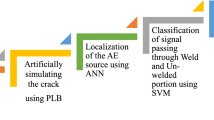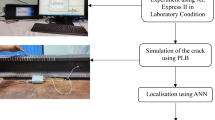Abstract
Objective
Railways, integral to global trade and transportation, face infrastructure vulnerabilities from heavy traffic and challenging environments. Timely fault monitoring is pivotal for effective risk mitigation. Acoustic emission (AE) techniques, particularly in non-destructive testing (NDT), provide real-time health monitoring for railway track. However, traditional AE methods, especially signal processing, prove complex and time-intensive for fault localization. Recent studies explore the potential of Artificial Intelligence (AI), specifically neural networks, for fault detection, yet lack a systematic approach to parameter weighting.
Methodology
This study bridges this gap by systematically evaluating weights assigned to the AE parameters to enhance fault detection accuracy. Laboratory and field-tested AE sensor data from railway track assess the significance of parameters such as Amplitude, Peak Frequency, Counts, RMS, Energy, Rise Time, Duration. As carriers of crucial fault information within the AE signal. A novel methodology introduces distinct weights to individual AE parameters based on their importance, refining the AI model's focus on critical attributes. Extensive laboratory experiments simulate damage in various rail sections, assessing the AI model's fault localization efficiency, robustness, and accuracy using an Artificial Neural Network (ANN) model.
Results and Conclusions
The ANN model demonstrates superiority in precise fault localization, affirming its efficacy. The proposed methodology presented herein, validated through rigorous assessments in both controlled laboratory environments and real-world field conditions, stands as a noteworthy advancement in the realm of smart fault detection in real-time.


















Similar content being viewed by others
Data Availability
Research-related data may be made public upon request without violating the future scope. Researchers can get in touch with the corresponding author for this reason.
References
Kostryzhev AG, Davis CL, Roberts C (2013) Detection of crack growth in rail steel using acoustic emission. Ironmaking Steelmaking 40(2):98–102. https://doi.org/10.1179/1743281212Y.0000000051
Wevers M (1997) Listening to the sound of materials: acoustic emission for the analysis of material behaviour. NDT and E Int 30(2):99–106. https://doi.org/10.1016/S0963-8695(96)00051-5
Murav’ev VV, Murav’ev MV, Murav’ev TV (2008) The possibilities of acoustic emission testing of rails during exploitation. Russian J Nondestructive Testing. 44(1): pp. 33-40. https://doi.org/10.1134/S106183090801004X
Marais JJ, Mistry KC (2003) Rail integrity management by means of ultrasonic testing. Fatigue Fract Eng Mater Struct 26(10):931–938. https://doi.org/10.1046/j.1460-2695.2003.00668.x
Bombarda D, Vitetta GM, Ferrante G (2021) Rail diagnostics based on ultrasonic guided waves: an overview. Appl Sci 11(3):1071. https://doi.org/10.3390/app11031071
Kundu T (2014) Acoustic source localization. Ultrasonics 54(1):25–38. https://doi.org/10.1016/j.ultras.2013.06.009
Shiotani T, Ohtsu M (1999) Prediction of slope failure based on AE activity. ASTM Spec Tech Publ 1353:156–174
Shiotani T (2006) Evaluation of long-term stability for rock slope by means of acoustic emission technique. NDT and E Int 39(3):217–228. https://doi.org/10.1016/j.ndteint.2005.07.005
Behnia A, Chai HK, Shiotani T (2014) Advanced structural health monitoring of concrete structures with the aid of acoustic emission. Constr Build Mater 65:282–302. https://doi.org/10.1016/j.conbuildmat.2014.04.103
Hsu NN, FR B (1981) Characterization and calibration of acoustic emission sensors. http://pascal-francis.inist.fr/vibad/index.php?action=getRecordDetail&idt=PASCAL8130189718
Pal A, Kundu T, Datta AK (2023) Assessing the influence of welded joint on health monitoring of rail sections: an experimental study employing SVM and ANN models. J Nondestruct Eval 42:102. https://doi.org/10.1007/s10921-023-01014-z
Huang L, Ding J, Lin J, Luo Z (2023) Detection and localization of corrosion using identical-group-velocity Lamb wave modes. Nondestructive Testing Eval 1–20. https://doi.org/10.1080/10589759.2023.2218007
Dris EY, Drai R, Benammar A, Berkani D (2017) Acoustic emission source localization in plate-like structure. european conference on electrical engineering and computer science (EECS), Bern, Switzerland, pp. 193–197, https://doi.org/10.1109/EECS.2017.44.
Clark R (2004) Rail flaw detection: overview and needs for future developments. NDT and E Int 37(2):111–118. https://doi.org/10.1016/j.ndteint.2003.06.002
Zhang X, Sun T, Wang Y, Wang K, Shen Y (2021) A parameter optimized variational mode decomposition method for rail crack detection based on acoustic emission technique. Nondestructive Testing and Evaluation 36(4):411–439. https://doi.org/10.1080/10589759.2020.1785447
Sohaib M, Islam M, Kim J, Jeon DC, Kim JM (2019) Leakage detection of a spherical water storage tank in a chemical industry using acoustic emissions. Appl Sci 9(1):196. https://doi.org/10.3390/app9010196
Bassim MN (1992) Detection of fatigue crack propagation with acoustic emission. NDT and E Int 25(6):287–289. https://doi.org/10.1016/0963-8695(92)90639-X
Liao TW (2010) Feature extraction and selection from acoustic emission signals with an application in grinding wheel condition monitoring. Eng Appl Artif Intell 23(1):74–84. https://doi.org/10.1016/j.engappai.2009.09.004
Roy P, Datta AK, Topdar P (2023) A study on the efficacy of modal acoustic emission technique for health monitoring of structures with different geometries. Nondestructive Testing and Evaluation, 1–40. https://doi.org/10.1080/10589759.2023.2231611
Kundu T, Datta AK, Roy P, Topdar P, Banerjee A, Mukerjee A, Pal A (2023) An experimental study on health monitoring of rail section using an indigenously developed AE system. Int J Struct Eng 13(4): 463–481. https://doi.org/10.1504/IJSTRUCTE.2023.134346
Pal A, Kundu T, Datta AK (2023) Sensor-based smart diagnosis of rail defects using an ann model. Asian J Civ Eng 1–8. https://doi.org/10.1007/s42107-023-00690-6
Nick H, Ashrafpoor A, Aziminejad A (2023) Damage identification in steel frames using dual-criteria vibration-based damage detection method and artificial neural network. In Structures 51:1833–1851. https://doi.org/10.1016/j.istruc.2023.03.152
Zhang X, Feng N, Wang Y, Shen Y (2015) Acoustic emission detection of rail defect based on wavelet transform and Shannon entropy. J Sound Vib 339:419–432. https://doi.org/10.1016/j.jsv.2014.11.021
Kundu T, Roy P, Datta AK, Topdar P (2022) Health monitoring of Indian rail section using AE technique combined with UPVM: An experimental study. J Struct Eng 49(1): 1–11. https://serc.res.in/jose-contents
Kundu T, Pal A, Roy P, Datta AK, Topdar P (2022) Application of UPV-instrument in health monitoring of Indian rail section using AE technique. In ASPS Conference Proceedings (Vol. 1, No. 5, pp. 1429–1439). https://doi.org/10.38208/acp.v1.673
Ebrahimkhanlou A, Salamone S (2018) Single-sensor acoustic emission source localization in plate-like structures using deep learning. Aerospace 5(2):50. https://doi.org/10.3390/aerospace5020050
Yu Y, Li J, Li J, Xia Y, Ding Z, Samali B (2023) Automated damage diagnosis of concrete jack arch beam using optimized deep stacked autoencoders and multi-sensor fusion. Developments in the Built Environment 14:100128. https://doi.org/10.1016/j.dibe.2023.100128
Chlada M, Prevorovsky Z, Blahacek M (2010) Neural network AE source location apart from structure size and material. J Acoust Emiss 28:99–108
Yu Y, Hoshyar AN, Samali B, Zhang G, Rashidi M, Mohammadi M (2023) Corrosion and coating defect assessment of coal handling and preparation plants (CHPP) using an ensemble of deep convolutional neural networks and decision-level data fusion. Neural Comput Appl 1–22. https://doi.org/10.1007/s00521-023-08699-3
Cheng L, Xin H, Groves RM, Veljkovic M (2021) Acoustic emission source location using Lamb wave propagation simulation and artificial neural network for I-shaped steel girder. Constr Build Mater 273:121706. https://doi.org/10.1016/j.conbuildmat.2020.121706
Saadatmorad M, Jafari-Talookolaei RA, Pashaei MH (2022) Damage detection in rectangular laminated composite plate structures using a combination of wavelet transforms and artificial neural networks. J Vib Eng Technol 10:1647–1664. https://doi.org/10.1007/s42417-022-00471-6
Uygun E, Terzi S (2023) Acoustic monitoring of railway defects using deep learning with audio to spectrogram conversion. J Vib Eng Technol. https://doi.org/10.1007/s42417-023-01001-8
Cervantes-Bobadilla M, García-Morales J, Saavedra-Benítez YI, Hernández-Pérez JA, Adam-Medina M, Guerrero-Ramírez GV, Escobar-Jímenez RF (2023) Multiple fault detection and isolation using artificial neural networks in sensors of an internal combustion engine. Eng Appl Artif Intell 117:105524. https://doi.org/10.1016/j.engappai.2022.105524
Kuchak AJT, Marinkovic D, Zehn M (2021) Parametric investigation of a rail damper design based on a lab-scaled model. J Vib Eng Technol 9:51–60. https://doi.org/10.1007/s42417-020-00209-2
Kundu T, Pal A, Roy P, Datta AK, Topdar P (2023) Development of a novel real-time AE source localisation technique using ANN for health monitoring of rail section: an experimental study. Structural Health Monitoring, 14759217231171026. https://doi.org/10.1177/14759217231171026
Pal A, Kundu T, Datta AK (2023) Damage localization in Rail Section using single AE sensor data: An experimental Investigation with deep learning approach. Nondestructive Testing and Evaluation, 1–19 https://doi.org/10.1080/10589759.2023.2243004
Zhang X, Hao Q, Wang K, Wang Y, Shen Y, Hu H (2018) An investigation on acoustic emission detection of rail crack in actual application by chaos theory with improved feature detection method. J Sound Vib 436:165–182. https://doi.org/10.1016/j.jsv.2018.09.014
Zhang X, Zou Z, Wang K, Hao Q, Wang Y, Shen Y, Hu H (2018) A new rail crack detection method using LSTM network for actual application based on AE technology. Appl Acoust 142:78–86. https://doi.org/10.1016/j.apacoust.2018.08.020
Kalafat S, Sause MG (2015) Acoustic emission source localization by artificial neural networks. Struct Health Monit 14(6):633–647. https://doi.org/10.1177/1475921715607408
Kuang KSC, Li D, Koh CG (2016) Acoustic emission source location and noise cancellation for crack detection in rail head. Smart Struct Syst 18(5):1063–1085. https://doi.org/10.12989/sss.2016.18.5.1063
Kundu T, Datta AK, Topdar P, Sengupta S (2022) Optimal location of acoustic emission sensors for detecting rail damage. Proceedings of the Institution of Civil Engineers-Structures and Buildings, 1–10. https://doi.org/10.1680/jstbu.21.00074
Shiao YC, Chakraborty G, Chen SF, Li LH, Chen RC (2019). Modeling and prediction of time-series-a case study with forex data. In: 2019 IEEE 10th international conference on awareness science and technology (ICAST) (pp. 1–5). IEEE. https://doi.org/10.1109/ICAwST.2019.8923188
Di Q, Dai L, Wang Y, Zanobetti A, Choirat C, Schwartz JD, Dominici F (2017) Association of short-term exposure to air pollution with mortality in older adults. JAMA 318(24):2446–2456. https://doi.org/10.1001/jama.2017.17923
Zhang J, Henriksson G, Johansson G (2000) Polygalacturonase is the key component in enzymatic retting of flax. J Biotechnol 81(1):85–89. https://doi.org/10.1016/S0168-1656(00)00286-8
Battiti R (1994) Using mutual information for selecting features in supervised neural net learning. IEEE Trans Neural Networks 5(4):537–550. https://doi.org/10.1109/72.298224
Qiao J, Li S, Li W (2016) Mutual information based weight initialization method for sigmoidal feedforward neural networks. Neurocomputing 207:676–683. https://doi.org/10.1016/j.neucom.2016.05.054
Acknowledgements
The authors would like to thank the Section Engineer, Durgapur, E-RLY, Indian Railway, for supplying the rail section used and for the field data collection for this research. This project has been supported by DST-TSDP, Government of India.
Funding
The author(s) of this article certify that they did not receive any grants, money, or other financial assistance for this article's research, authorship and/or publication.
Author information
Authors and Affiliations
Contributions
The experiment was carried out by AP, who also wrote the manuscript. Dr. AKD reviewed the manuscript and supervised the experiment.
Corresponding author
Ethics declarations
Conflict of Interest
The author(s) declared no potential conflicts of interest with respect to the research, authorship and/or publication of this article.
Ethical Approval
Not Applicable.
Consent of Participate
Not Applicable.
Consent for Publication
All authors consent to the publication of this work.
Additional information
Publisher's Note
Springer Nature remains neutral with regard to jurisdictional claims in published maps and institutional affiliations.
Rights and permissions
Springer Nature or its licensor (e.g. a society or other partner) holds exclusive rights to this article under a publishing agreement with the author(s) or other rightsholder(s); author self-archiving of the accepted manuscript version of this article is solely governed by the terms of such publishing agreement and applicable law.
About this article
Cite this article
Pal, A., Datta, A.K. Development of Smart Real-time Fault Detection Approach in Railway Track Deploying a Single Acoustic Emission Sensor Data. J. Vib. Eng. Technol. (2024). https://doi.org/10.1007/s42417-024-01374-4
Received:
Revised:
Accepted:
Published:
DOI: https://doi.org/10.1007/s42417-024-01374-4




